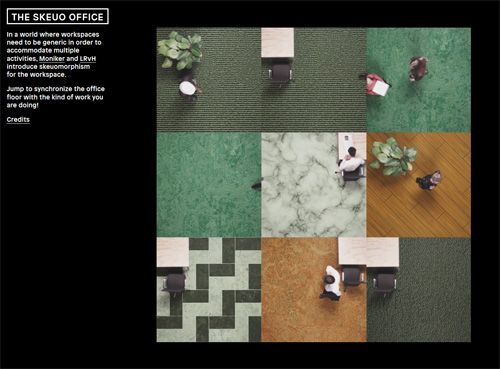Friday, September 05. 2014
Skeuo Office ? | #nothankyou
A little bit of irony about skeuomorphism by Studio Moniker in their video for the "office of the future". It looks like the real offices of Google though, according to the many pictures that have populated the web about their offices interior design... I hope Google glasses don't make you see the world that way btw.
Via Moniker
-----
"In a world where workspaces need to be generic in order to accommodate multiple activities, Moniker and LRvH introduce skeuomorphism for the workspace.
Jump to synchronize the office floor with the kind of work you are doing!"
So, do you believe that Google employees are jumping too to synchronize their working space?
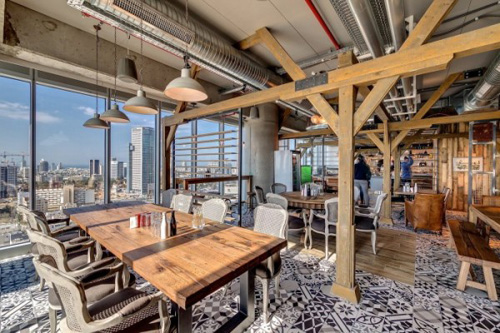
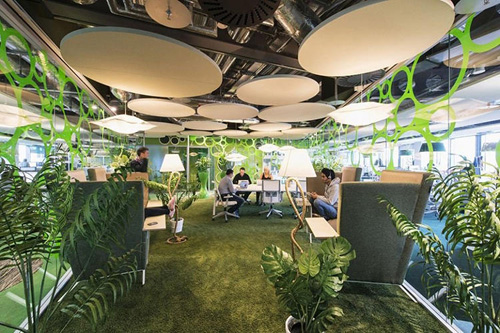
Thursday, July 24. 2014
What Else Could Smart Contact Lenses Do? | #vision
-----
Besides health tracking, contact lens technology under development could enable drug delivery, night vision, and augmented reality.
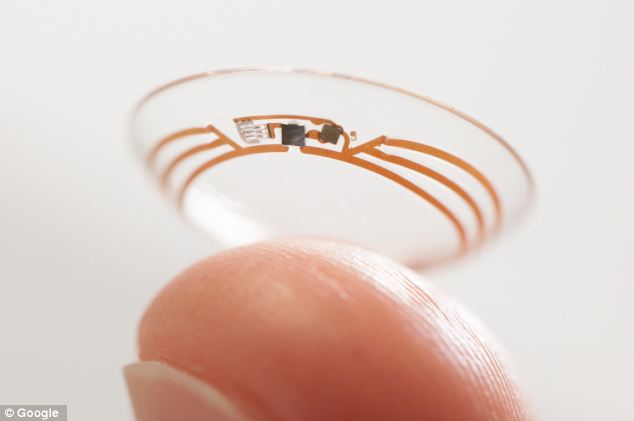
Last week Google and Novartis announced that they’re teaming up to develop contact lenses that monitor glucose levels and automatically adjust their focus. But these could be just the start of a clever new product category. From cancer detection and drug delivery to reality augmentation and night vision, our eyes offer unique opportunities for both health monitoring and enhancement.
“Now is the time to put a little computer and a lot of miniaturized technologies in the contact lens,” says Franck Leveiller, head of research and development in the Novartis eye care division.
One of the Novartis-Google prototype lenses contains a device about the size of a speck of glitter that measures glucose in tears. A wireless antenna then transmits the measurements to an external device. It’s designed to ease the burden of diabetics who otherwise have to prick their fingers to test their blood sugar levels.
“I have many patients that are managing diabetes, and they described it as having a part-time job. It’s so arduous to monitor,” says Thomas Quinn, who is head of the American Optometric Association’s contact lens and cornea section. “To have a way that patients can do that more easily and get some of their life back is really exciting.”
Glucose isn’t the only thing that can be measured from tears rather than a blood sample, says Quinn. Tears also contain a chemical called lacryglobin that serves as a biomarker for breast, colon, lung, prostate, and ovarian cancers. Monitoring lacryglobin levels could be particularly useful for cancer patients who are in remission, Quinn says.
Quinn also believes that drug delivery may be another use for future contact lenses. If a lens could dispense medication slowly over long periods of time, it would be better for patients than the short, concentrated doses provided by eye drops, he says. Such a lens is not easy to make, though (see “A Drug-Dispensing Lens”).
The autofocusing lens is in an earlier stage of development, but the goal is for it to adjust its shape depending on where the eye is looking, which would be especially helpful for people who need reading glasses. A current prototype of the lens uses photodiodes to detect light hitting the eye and determine whether the eye is directed downward. Leveiller says the team is also looking at other possible techniques.
Google and Novartis are far from the only ones interesting in upgrading the contact lens with such new capabilities. In Sweden, a company called Sensimed is working on a contact lens that measures the intraocular pressure that results from the liquid buildup in the eyes of glaucoma patients (see “Glaucoma Test in a Contact Lens”). And researchers at the University of Michigan are using graphene to make infrared-sensitive contact lenses—the vision, as it were, is that these might one day provide some form of night vision without the bulky headgear.
A Seattle-based company, Innovega, meanwhile, has developed a contact lens with a small area that filters specific bands of red, green, and blue light, giving users the ability to focus on a very small, high resolution display less than an inch away from their eyes without interfering with normal vision. That makes tiny displays attached to glasses look more like IMAX movie screens, says the company’s CEO, Steve Willey. Together, the lens and display are called iOptik.
Plenty of challenges still remain before we’re all walking around with glucose-monitoring, cancer-detecting, drug-delivering super night vision. Some prototypes out there are unusually thick, Quinn says, and some use traditional, rigid electronics where clear, flexible alternatives would be preferable. And, of course, all will have to pass regulatory approval to show they are safe and effective.
Jeff George, the head of the Novartis eye care division, is certainly optimistic about Google’s smart lens. “Google X’s team refers to themselves as a ‘moon shot factory.’ I’d view this as better than a moon shot given what we’ve seen,” he says.
Thursday, February 06. 2014
Wolfram moves to connected objects (too) | #responsive #objects
-----
"Launching the Wolfram Connected Devices Project"
January 6, 2014
“Connected devices are central to our long-term strategy of injecting sophisticated computation and knowledge into everything. With the Wolfram Language we now have a way to describe and compute about things in the world. Connected devices are what we need to measure and interface with those things.
“In the end, we want every type of connected device to be seamlessly integrated with the Wolfram Language. And this will have all sorts of important consequences. But as we work toward this, there’s an obvious first step: we have to know what types of connected devices there actually are.
“So to have a way to answer that question, today we’re launching the Wolfram Connected Devices Project—whose goal is to work with device manufacturers and the technical community to provide a definitive, curated, source of systematic knowledge about connected devices….”
(((Gosh there sure are lots of them.)))
Related Links:
Friday, January 24. 2014
Bracket [takes action] | #call
A new call by the very interesting Bracket magazine/books!
Via Bracket
-----
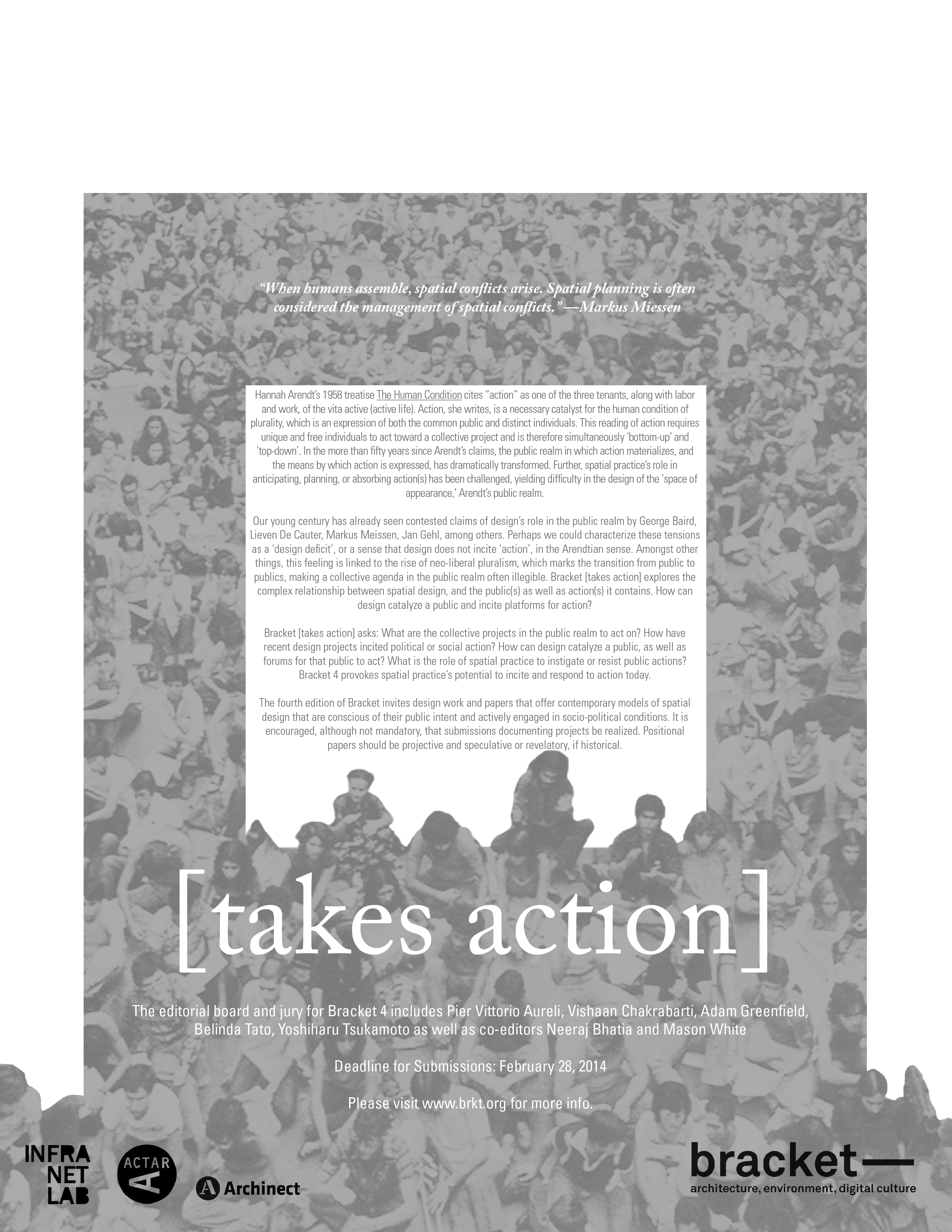
Bracket [takes action]
“When humans assemble, spatial conflicts arise. Spatial planning is often considered the management of spatial conflicts.” —Markus Miessen
Hannah Arendt’s 1958 treatise The Human Condition cites “action” as one of the three tenants, along with labor and work, of the vita active (active life). Action, she writes, is a necessary catalyst for the human condition of plurality, which is an expression of both the common public and distinct individuals. This reading of action requires unique and free individuals to act toward a collective project and is therefore simultaneously ‘bottom-up’ and ‘top-down’. In the more than fifty years since Arendt’s claims, the public realm in which action materializes, and the means by which action is expressed, has dramatically transformed. Further, spatial practice’s role in anticipating, planning, or absorbing action(s) has been challenged, yielding difficulty in the design of the ‘space of appearance,’ Arendt’s public realm.
Our young century has already seen contested claims of design’s role in the public realm by George Baird, Lieven De Cauter, Markus Meissen, Jan Gehl, among others. Perhaps we could characterize these tensions as a ‘design deficit’, or a sense that design does not incite ‘action’, in the Arendtian sense. Amongst other things, this feeling is linked to the rise of neo-liberal pluralism, which marks the transition from public to publics, making a collective agenda in the public realm often illegible. Bracket [takes action] explores the complex relationship between spatial design, and the public(s) as well as action(s) it contains. How can design catalyze a public and incite platforms for action?
Consider two images indicative of contemporary action within the public realm of our present century: (i) the June 2009 opening of the High Line Park in New York City, and (ii) the January 2011 occupation of Tahrir Square in Cairo. These two spaces and their respective contemporary publics embody the range within today’s space of appearance. At the High Line, the urban public is now choreographed in a top-down manner along a designed, former infrastructure with an endless supply of vistas into an urban private realm. In Tahrir Square, an assembled swirling public occupies, and therefore re-designs, an infrastructural plaza overwhelming a government and communication networks. This example reveals a bottom-up, self-assembling public. But what role did spatial practice play in each of these scenarios and who were the spatial practitioners and public(s)? The contrast of two positions on action in a public realm offers an opening for wider investigations into spatial practice’s role and impact on today’s public(s) and their action(s).
Bracket [takes action] asks: What are the collective projects in the public realm to act on? How have recent design projects incited political or social action? How can design catalyze a public, as well as forums for that public to act? What is the role of spatial practice to instigate or resist public actions? Bracket 4 provokes spatial practice’s potential to incite and respond to action today.
The fourth edition of Bracket invites design work and papers that offer contemporary models of spatial design that are conscious of their public intent and actively engaged in socio-political conditions. It is encouraged, although not mandatory, that submissions documenting projects be realized. Positional papers should be projective and speculative or revelatory, if historical. Suggested subthemes include:
Participatory ACTION – interactive, crowd-sourced, scripted
Disputed PUBLICS – inconsistent, erratic, agonized
Deviant ACTION – subversive, loopholes, reactive
Distributed PUBLICS – broadcasted, networked, diffused
Occupy ACTION – defiant, resistant, upheaval
Mob PUBLICS – temporary, forceful, performative
Market ACTION – abandoning, asserting, selecting
The editorial board and jury for Bracket 4 includes Pier Vittorio Aureli, Vishaan Chakrabarti, Adam Greenfield, Belinda Tato, Yoshiharu Tsukamoto as well as co-editors Neeraj Bhatia and Mason White.
Deadline for Submissions: February 28, 2014
Please visit www.brkt.org for more info.
Related Links:
Friday, September 20. 2013
How to make players sick in your virtual reality game
Via Joystiq
-----
There is a great, undiscovered potential in virtual reality development. Sure, you can create lifelike virtual worlds, but you can also make players sick. Oculus VR founder Palmer Luckey and VP of product Nate Mitchell hosted a panel at GDC Europe last week, instructing developers on how to avoid the VR development pitfalls that make players uncomfortable. It was a lovely service for VR developers, but we saw a much greater opportunity. Inadvertently, the panel explained how to make players as queasy and uncomfortable as possible.
And so, we now present the VR developer's guide to manipulating your players right down to the vestibular level. Just follow these tips and your players will be tossing their cookies in minutes.
Note: If you'd rather not make your players horribly ill and angry, just do the opposite of everything below.
Include lots of small, tight spaces
In virtual reality, small and closed-off areas truly feel small, said Luckey. "Small corridors are really claustrophobic. It's actually one of the worst things you can do for most people in VR, is to put them in a really small corridor with the walls and the ceiling closing in on them, and then tell them to move rapidly through it."
Meanwhile, open spaces are a "relief," he said, so you'll want to avoid those.
Possible applications: Air duct exploration game.
Create a user interface that neglects depth and head-tracking
Virtual reality is all about depth and immersion, said Mitchell. So, if you want to break that immersion, your ideal user interface should be as traditional and flat as possible.
For example, put targeting reticles on a 2D plane in the center of a player's field of view. Maybe set it up so the reticle floats a couple of feet away from the player's face. "That is pretty uncomfortable for most players and they'll just try to grapple with what do they converge on: That near-field reticle or that distant mech that they're trying to shoot at?" To sample this effect yourself, said Mitchell, you can hold your thumb in front of your eyes. When you focus on a distant object, your thumb will appear to split in two. Now just imagine that happening to something as vital a targeting reticle!
You might think that setting the reticle closer to the player will make things even worse, and you're right. "The sense of personal space can make people actually feel uncomfortable, like there's this TV floating righting in front of their face that they try to bat out of the way." Mitchell said a dynamic reticle that paints itself onto in-game surfaces feels much more natural, so don't do that.
You can use similar techniques to create an intrusive, annoying heads-up display. Place a traditional HUD directly in front of the player's face. Again, they'll have to deal with double vision as their eyes struggle to focus on different elements of the game. Another option, since VR has a much wider field of view than monitors, is to put your HUD elements in the far corners of the display, effectively putting it into a player's peripheral vision. "Suddenly it's too far for the player to glance at, and they actually can't see pretty effectively." What's more, when players try to turn their head to look at it, the HUD will turn with them. Your players will spin around wildly as they desperately try to look at their ammo counter.
Possible applications: Any menu or user interface from Windows 3.1.
Disable head-tracking or take control away from the player
"Simulator sickness," when players become sick in a VR game, is actually the inverse of motion sickness, said Mitchell. Motion sickness is caused by feeling motion without being able to see it ? Mitchell cited riding on a boat rocking in the ocean as an example. "There's all this motion, but visually you don't perceive that the floor, ceiling and walls are moving. And that's what that sensory disconnect ? mainly in your vestibular senses ? is what creates that conflict that makes you dizzy." Simulator sickness he said, is the opposite. "You're in an environment where you perceive there to be motion, visually, but there is no motion. You're just sitting in a chair."
If you disable head-tracking in part of your game, it artificially creates just that sort of sensory disconnect. Furthermore, if you move the camera without player input, say to display a cut-scene, it can be very disorienting. When you turn your head in VR, you expect the world to turn with you. When it doesn't, you can have an uncomfortable reaction.
Possible applications: Frequent, Unskippable Cutscenes: The Game.
Feature plenty of backwards and lateral movement
Forward movement in a VR game tends not to cause problems, but many users have trouble dealing with backwards movement, said Mitchell. "You can imagine sometimes if you sit on a train and you perceive no motion, and the train starts moving backwards very quickly, or you see another car pulling off, all of those different sensations are very similar to that discomfort that comes from moving backwards in space." Lateral movement ? i.e. sideways movement ? has a similar effect, Mitchell said. "Being able to sort of strafe on a dime doesn't always cause the most comfortable experience."
Possible applications: Backwards roller coaster simulator.
Quick changes in altitude
"Quick changes in altitude do seem to cause disorientation," said Mitchell. Exactly why that happens isn't really understood, but it seems to hold true among VR developers. This means that implementing stairs or ramps into your games can throw players for a loop ? which, remember, is exactly what we're after. Don't use closed elevators, as these prevent users from perceiving the change in altitude, and is generally much more comfortable.
Possible applications: A VR version of the last level from Ghostbusters on NES. Also: Backwards roller coaster simulator.
Don't include visual points of reference
When players look down in VR, they expect to see their character's body. Likewise, in a space combat or mech game, they expect to see the insides of the cockpit when they look around. "Having a visual identity is really crucial to VR. People don't want to look down and be a disembodied head." For the purposes of this guide, that makes a disembodied head the ideal avatar for aggravating your players.
Possible applications: Disembodied Heads ... in ... Spaaaaaace. Also: Disembodied head in a backwards roller coaster.
Shift the horizon line
Okay, this is probably one of the most devious ways to manipulate your players. Mitchell imagines a simulation of sitting on a beach, watching the sunset. "If you subtly tilt the horizon line very, very minimally, a couple degrees, the player will start to become dizzy and disoriented and won't know why."
Possible applications: Drunk at the Beach.
Shoot for a low frame rate, disable V-sync
"With VR, having the world tear non-stop is miserable." Enough said. Furthermore, a low frame rate can be disorienting as well. When players move their heads and the world doesn't move at the same rate of speed, its jarring to their natural senses.
Possible applications: Limitless.
In Closing
Virtual reality is still a fledgling technology and, as Luckey and Mitchell explained, there's still a long way to go before both players and developers fully understand it. There are very few points of reference, and there is no widely established design language that developers can draw from.
What Luckey and Mitchell have detailed - and what we've decided to ignore - is a basic set of guidelines on maintaining player comfort in the VR space. Fair warning though, if you really want to design a game that makes players sick, the developers of AaaaaAAaaaAAAaaAAAAaAAAAA!!! already beat you to it.
Friday, September 06. 2013
Landscape Futures Arrives
Via BLDGBLOG
-----
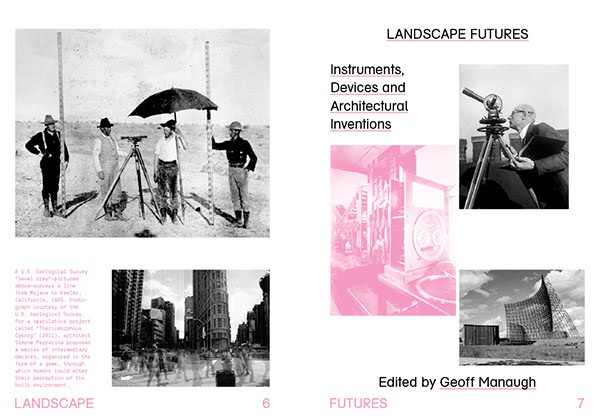
[Image: Internal title page from Landscape Futures; book design by Everything-Type-Company].
At long last, after a delay from the printer, Landscape Futures: Instruments, Devices and Architectural Inventions is finally out and shipping internationally.
I am incredibly excited about the book, to be honest, and about the huge variety of content it features. It includes original essays by Sam Jacob, Cassim Shepard, and Elizabeth Ellsworth & Jamie Kruse of Smudge Studio; a short piece of dredge-themed landscape fiction by Pushcart Prize-winning author Scott Geiger; and a readymade course outline—open for anyone looking to teach a course on oceanographic instrumentation—by Mammoth's Rob Holmes.
These join reprints of classic texts by geologist Jan Zalasiewicz, on the incipient fossilization of our cities 100 million years from now; a look at the perverse history of weather warfare and the possibility of planetary-scale climate manipulation by James Fleming; and a brilliant analysis of the Temple of Dendur, currently held deep in the controlled atmosphere of New York's Metropolitan Museum of Art, and its implications for architectural preservation elsewhere.
And even these are complemented by an urban hiking tour by the Center for Land Use Interpretation that takes you up into the hills of Los Angeles to visit check dams, debris basins, radio antennas, and cell phone towers, and a series of ultra-short stories set in a Chicago yet to come by Pruned's Alexander Trevi.
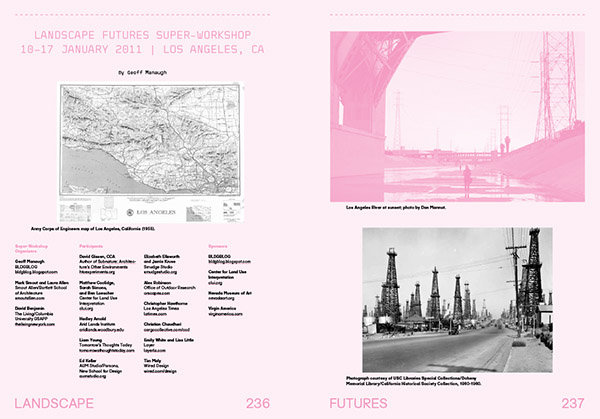
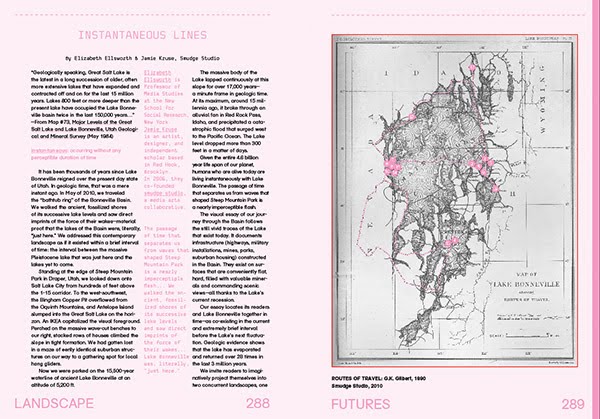


[Images: A few spreads from the "Landscape Futures Sourcebook" featured in Landscape Futures; book design by Everything-Type-Company].
Of course, everything just listed supplements and expands on the heart of the book, which documents the eponymous exhibition hosted at the Nevada Museum of Art, featuring specially commissioned work by Smout Allen, David Gissen, and The Living, and pre-existing work by Liam Young, Chris Woebken & Kenichi Okada, and Lateral Office.
Extensive original interviews with the exhibiting architects and designers, and a long curator's essay—describing the exhibition's focus on the intermediary devices, instruments, and spatial machines that can fundamentally transform how human beings perceive and understand the landscapes around them—complete the book, in addition to hundreds of images, many maps, and an extensive use of metallic and fluorescent inks.
The book is currently only $17.97 on Amazon.com, as well, which seems like an almost unbelievable deal; now is an awesome time to buy a copy.
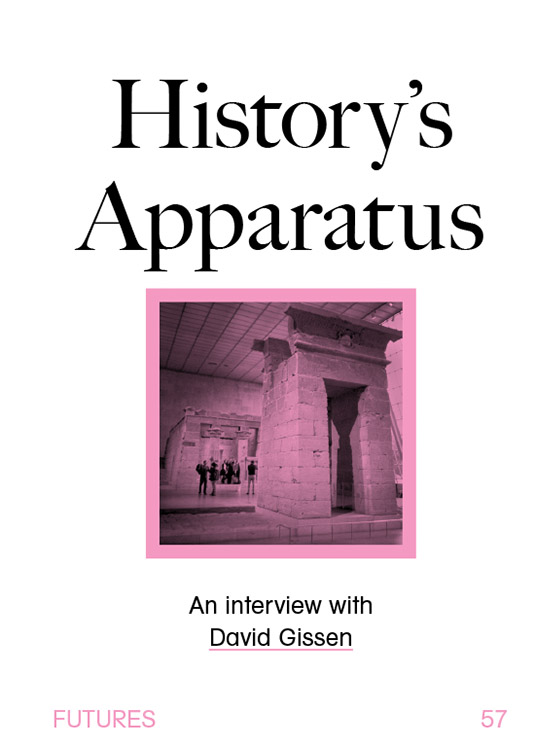
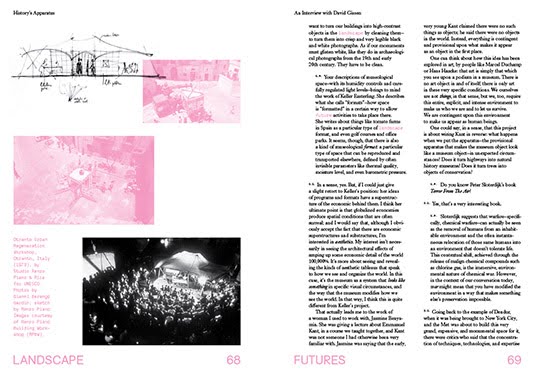
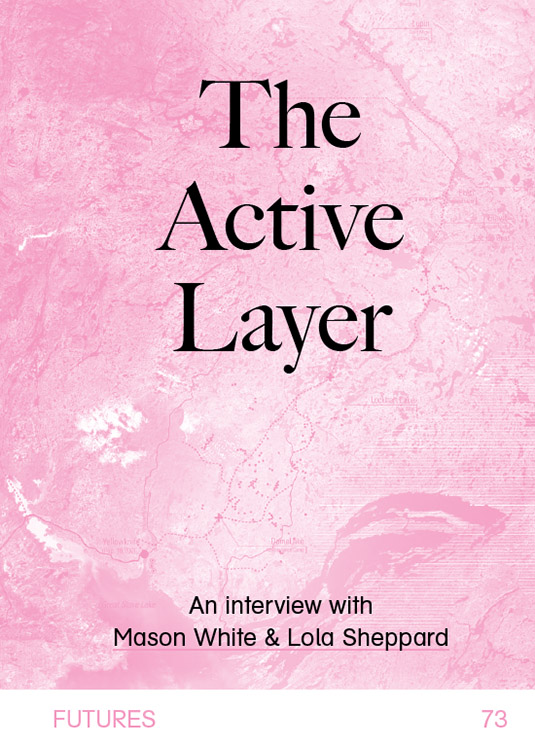
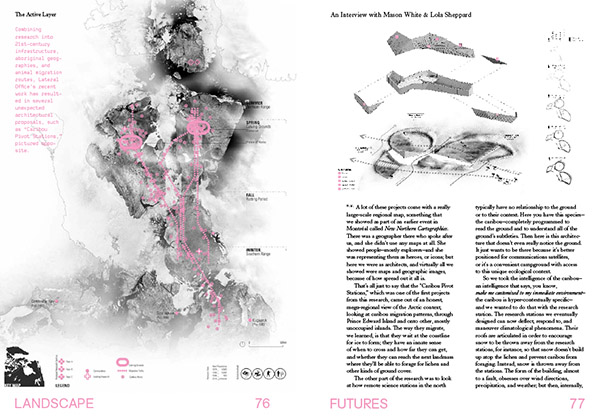
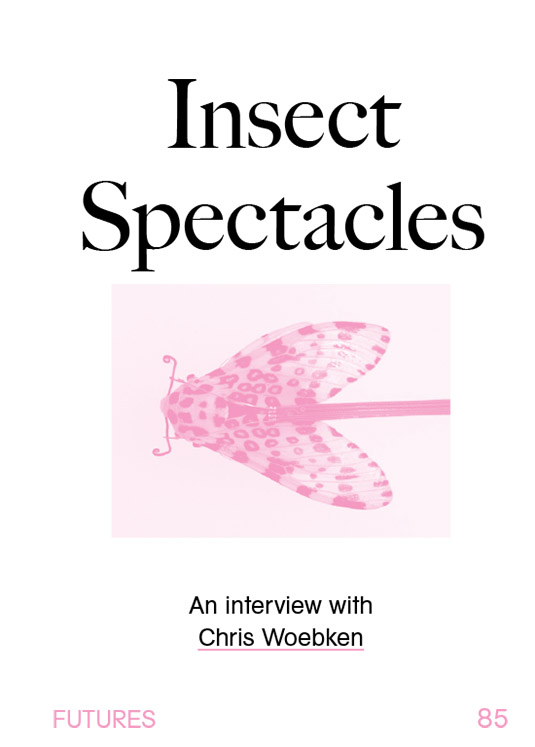
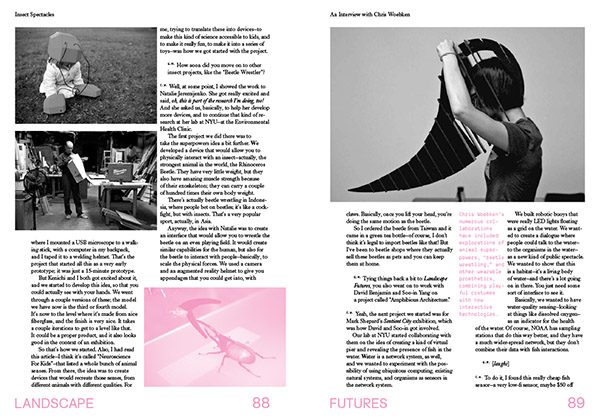
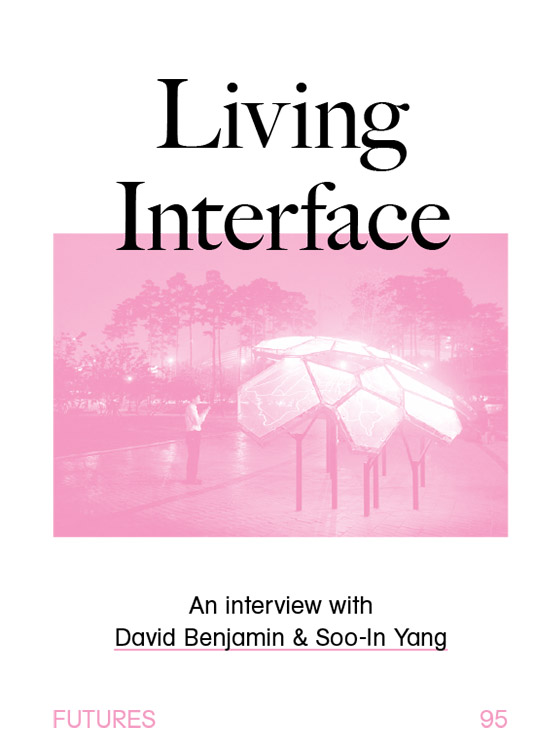
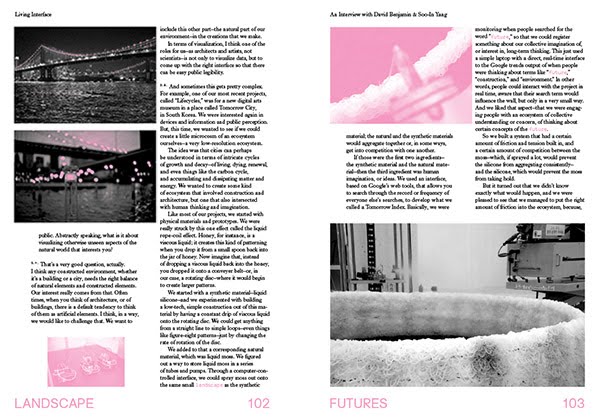

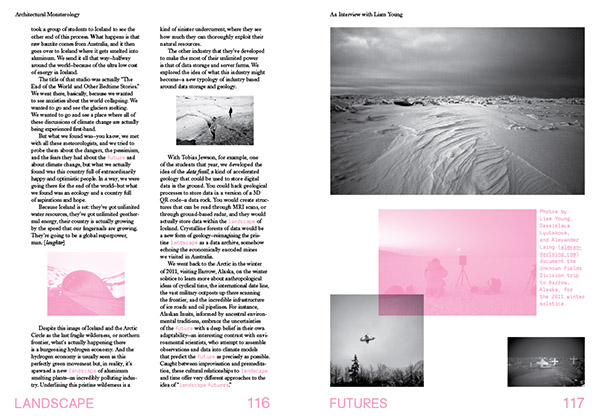
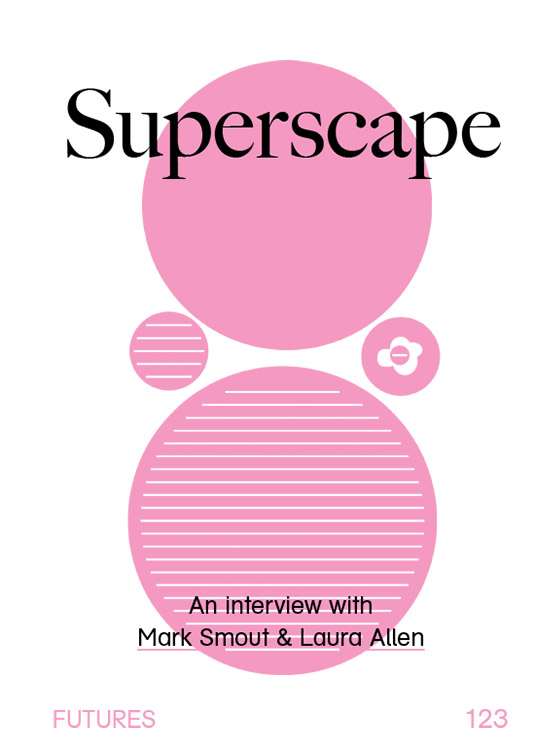

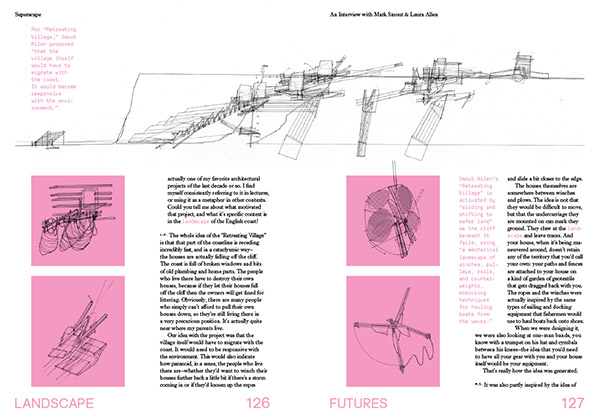
[Images: Interview spreads from Landscape Futures; book design by Everything-Type-Company].
In any case, I've written about Landscape Futures here before, and an exhaustive preview of it can be seen in this earlier post.
I just wanted to put up a notice that the book is finally shipping worldwide, with a new publication date of August 2013, and I look forward to hearing what people think. Enjoy!
Friday, January 18. 2013
INABA Completes Skylight
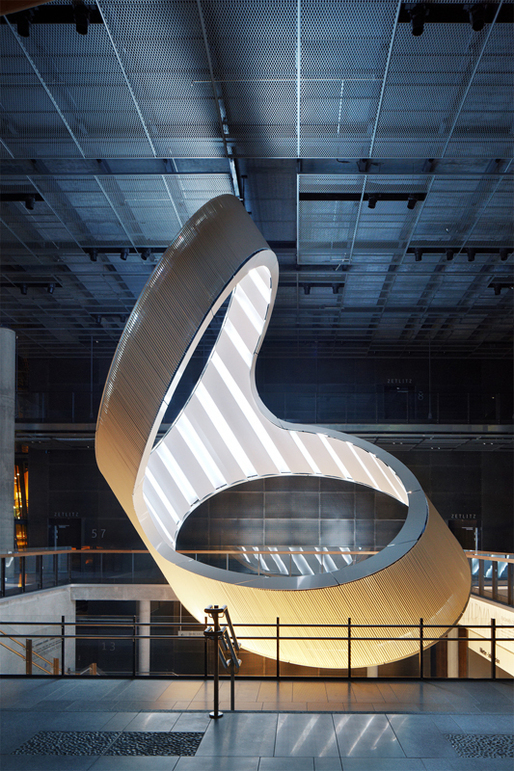
INABA has completed Skylight, a permanent installation for KORO Public Art Norway. The 6.6 m (22 ft) diameter, 11.5 m (38 ft) long structure hangs from the foyer of the New Concert Hall in Stavanger, Norway. It is visible from the adjacent public plaza, and surrounding neighborhood and harbor, serving as a light beacon for the complex. Responding to the region’s extreme atmospheric conditions, Skylight emits a range of pure color light patterns that contrast and complement the blended luminous tones of the dawn and twilight Nordic sky. Conceived of as an inverted chandelier, Skylight’s light fixtures are mounted to face inward and illuminate the structure’s interior surface. Its programmable LED system is animated to change in brightness and hue, and produce distinct patterns during arrival, theater calls, intermission, departure, and after hours.

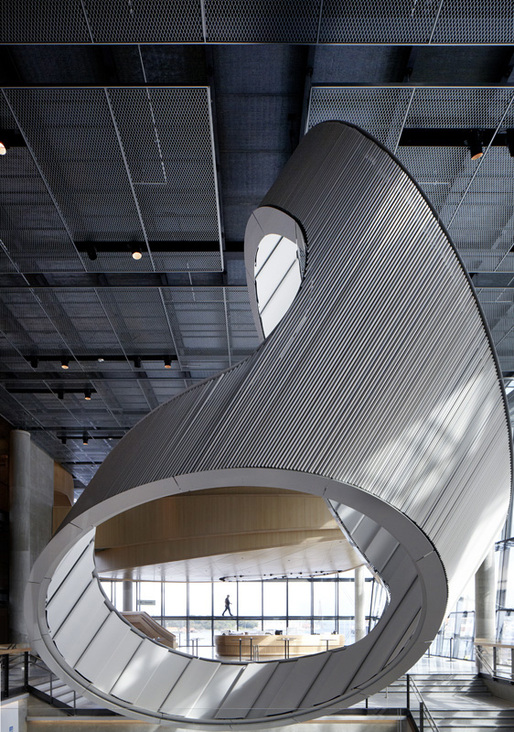
Skylight is based on a simple cylinder. Areas along the surface of the cylinder were removed to create views from the five-stor.
Related Links:
Monday, December 31. 2012
Here are some balloons, they are floating

William Forsythe: Scattered Crowds
We’ve seen some fantastic installation art recently, ranging from the Interactive Thunderstorm in Philadelphia, to The Rain Room in London. And now – joy of joys – we’re reflecting on more amazing installation art for y’all to dive into. This time we’re in the Bockenhelmer Depot, in Frankfurt, Germany. Ready? Right, let’s GO!
The magical spacial installation Scattered Crowds was conceived of by multi-disciplinary artist William Forsythe. Thousands of white balloons are suspended in the air, accompanied by a wash of music, emphasising “the air-borne landscape of relationships, distance, of humans and emptiness, of coalescence and decision”. Obviously, keep your eyes open and finish reading my little post, but this installation is well worth taking five; Put some tunes on and visualise your world surrounded by balloons. What would you do? How would you move?
And that’s the physical point of the installation – you’re forced to interact with each balloon which requires effort to manoeuvre, dodge, dance pass, or simply run headlong through like a sexually charged elephant. William’s installation draws this out of everybody who interacts with it, replicating the emotions and decisions of people. With this in mind, please – no pins!

William Forsythe: Scattered Crowds

William Forsythe: Scattered Crowds

William Forsythe: Scattered Crowds

William Forsythe: Scattered Crowds

William Forsythe: Scattered Crowds
Related Links:
Wednesday, January 25. 2012
Gardens as Crypto-Water-Computers
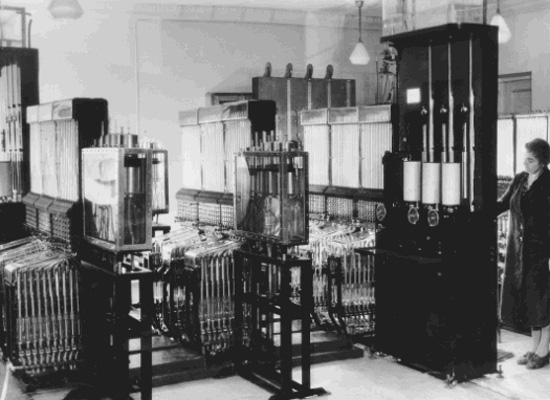
(Vladimir Lukyanov's water computer, 1936. Image courtesy of the Polytechnic Museum, Moscow.)
I only recently found out about Google's reverse image search functionality. Since then I've been busy feeding its search engine some of the more mysterious images that have been littering my archives for years, hoping finally to figure out what they are actually pictures of, and why I even found them interesting enough to keep in the first place.
One of those images is the one you see above. According to a translation of this article published by the Russian magazine Science and Life in 2000, it shows one of the “monuments of science and technology” that “brought [the Soviet Union] to the forefront of the analog computer” — Vladimir Lukyanov's marvelous water computer.
Built in 1936, this machine was “the world's first computer for solving [partial] differential equations,” which “for half a century has been the only means of calculations of a wide range of problems in mathematical physics.” Absolutely its most amazing aspect is that solving such complex mathematical equations meant playing around with a series of interconnected, water-filled glass tubes. You “calculated” with plumbing.
To better explain how it works, here is a description by Steven Strogatz of what I'm assuming is a comparative device. Built in 1949, nearly a decade and a half after Lukyonov's, it's called the Phillips machine, after its inventor, Bill Phillips.
In the front right corner, in a structure that resembles a large cupboard with a transparent front, stands a Rube Goldberg collection of tubes, tanks, valves, pumps and sluices. You could think of it as a hydraulic computer. Water flows through a series of clear pipes, mimicking the way that money flows through the economy. It lets you see (literally) what would happen if you lower tax rates or increase the money supply or whatever; just open a valve here or pull a lever there and the machine sloshes away, showing in real time how the water levels rise and fall in various tanks representing the growth in personal savings, tax revenue, and so on.
“It’s a network of dynamic feedback loops,” Strogatz further writes. “In this sense the Phillips machine foreshadowed one of the most central challenges in science today: the quest to decipher and control the complex, interconnected systems that pervade our lives.”

(A diagram of the Philips machine, alternatively named the “Moniac” by a Chicago economist “to suggest money, the ENIAC, and something maniacal.” Source.)
To go back to Lukyanov, his water computer was built specifically to solve the problem of cracking in concrete, a “scourge” that slowed the construction of railroads by his employer. Doing so meant developing manufacturing regimes for concrete blocks that take into account the complex relationships between material properties, the curing process and environmental conditions. Existing “calculation methods were not able to give fast and accurate solutions.” Lukyanov's invention could.
Appropriating and altering Strogatz's text, we get:
Filling up not just a corner but the entire room, inside not one but several structures that resemble large cupboards with a transparent front, is a Rube Goldberg collection of tubes, tanks, valves, pumps and sluices. You could think of it as a hydraulic computer. Water flows through a series of clear pipes, mimicking the production line of concrete blocks. It lets you see (literally) what would happen if you change the type of cement used or increase the load capacity of the concrete or whatever; just open a valve here or pull a lever there and the machine sloshes away, showing in real time how the water levels rise and fall in various tanks representing material properties, curing time, temperature, and so on.
Changes to the water level in the “measuring tube” would be marked on a graph paper — “a kind of curve,” and “these marks build schedule, which was the solution of the problem.”
Because of the simplicity of their design and programming, subsequent models were “successfully used” in other fields such as geology, thermal physics metallurgy and rocket engineering. The first and second generations of digital electronic computers could not match their computing abilities. In the mid-1970s, they were still being used in “115 manufacturing, research and educational institutions located in 40 cities” across the Soviet Union. “Only in the early 80s” were digital computers cheap, configurable and powerful enough to match the “possibility of [the] hydraulic integrator.”
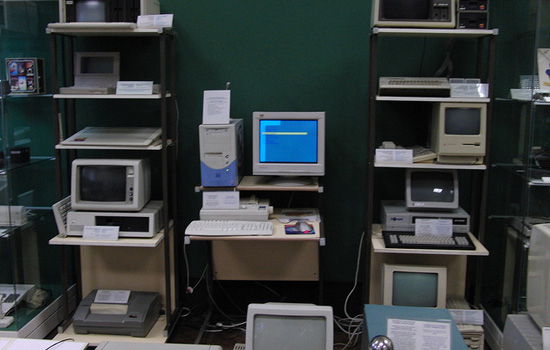
(A museum display at the Polytechnic Museum, Moscow, presenting an incomplete history of computers. Photo by Mikhail Shcherbakov. Source.)
Having briefly traced the history of water computers forward from Lukyanov to the rest of the 20th century, I can't help but thread the timeline backward to include some of the most elaborate hydraulic engineering schemes used in sprawling aristocratic gardens of early modern Europe, such as the always indispensable Versailles, the hydro-acoustically drenched Tivoli, the masterworks of Salomon and Isaac de Caus, and one of my top favorite gardens, Pratolino.
Garden historians usually characterize the technical control of water in stately gardens as part of a system of social control. As an alternative, or at least to offer another layer of meaning, this augmented timeline presents a crypto-historical narrative of gardens as gigantic water computers.

(Etienne Dupérac's bird's-eye plan view of the gardens at Villa d'Este, Tivoli. Source.)
All those water-screws, force pumps, water-lifting wheels, vents, wells and settling tanks, all those reservoirs, canals, aqueducts and pipes buried under mountains and rivers, and all those jets spurting out of vases and statuaries, creating water rainbows and sonic merriment, and all those fountains, water parterres, giochi d'acqua, automatas and damp grottos: those are the gurgling circuits, the programmable interfaces, the data storage devices and the visualization screens of landscape proto-supercomputers.
To operate it, you will have to consult an unpublished edition of Solomon de Caus's Les raisons des forces mouvantes, avec diverses machines tant utiles que plaisantes, auxquelles sont adjoints plusieurs dessings de grotes & fontaines, from which the following may have been excerpted:
Embedded in the earth is a Rube Goldberg collection of tubes, tanks, valves, pumps and sluices. You could think of it as a hydraulic computer. Water flows through a series of clear pipes, mimicking the way that money flows through the empire. It lets you see (literally) what would happen if you lower the price of bread or increase the construction of palaces or whatever; just open a valve here or pull a lever there and the machine in the garden sloshes away, showing in real time how the water levels rise and fall in various tanks representing colonial trade supplies, food riots, and so on.
Attached to the measuring tube is a series of fountains that gurgles the solution to the equation.

(Jean-Baptiste Martin, Vue du château de Versailles depuis le Bassin du Dragon et de Neptune, 1700. Source.)
Gardeners and their patrons would then walk around marking the fluctuating levels of these fountains on graphic paper. From fountain to fountain, they follow a set of programmed perambulations, gathering data at relevant nodal points, along the way not just picking up the solutions to the problem being computed but also gaining a greater understanding of the complexities of the natural and social worlds.
With these gardens as crypto-water-computers, they were taking measurements of the universe.
(See also La Machine de Marly.)
Friday, November 25. 2011
Flight Assembled Architecture by Gramazio & Kohler and Raffaello d’Andrea
de Rose Etherington
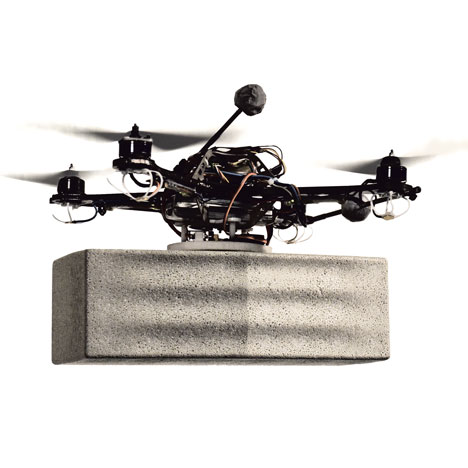
Flying robots will assemble a six metre-high tower at the FRAC Centre in Orléans, France, next month.

Created by Swiss architects Gramazio & Kohler and Raffaello D’Andrea, the mobile machines will lift, transport and assemble 1500 polystyrene foam bricks to build a 3.5 metre wide structure.
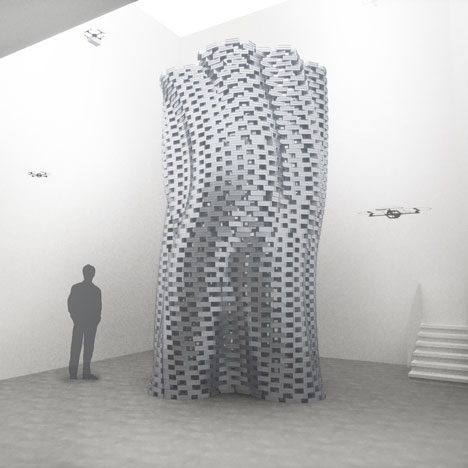
The installation will be on show from 2 December 2011 to 19 February 2012.
More about it HERE.
fabric | rblg
This blog is the survey website of fabric | ch - studio for architecture, interaction and research.
We curate and reblog articles, researches, writings, exhibitions and projects that we notice and find interesting during our everyday practice and readings.
Most articles concern the intertwined fields of architecture, territory, art, interaction design, thinking and science. From time to time, we also publish documentation about our own work and research, immersed among these related resources and inspirations.
This website is used by fabric | ch as archive, references and resources. It is shared with all those interested in the same topics as we are, in the hope that they will also find valuable references and content in it.
Quicksearch
Categories
Calendar
|
|
July '25 | |||||
| Mon | Tue | Wed | Thu | Fri | Sat | Sun |
| 1 | 2 | 3 | 4 | 5 | 6 | |
| 7 | 8 | 9 | 10 | 11 | 12 | 13 |
| 14 | 15 | 16 | 17 | 18 | 19 | 20 |
| 21 | 22 | 23 | 24 | 25 | 26 | 27 |
| 28 | 29 | 30 | 31 | |||
